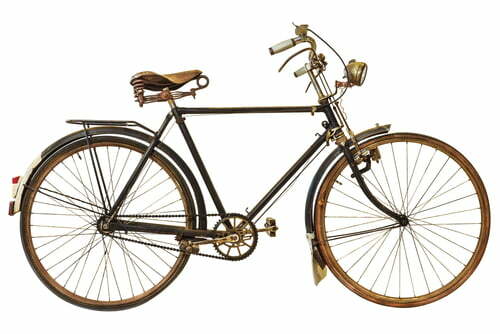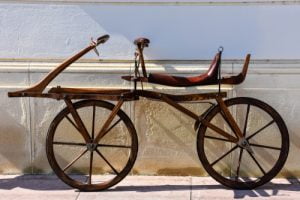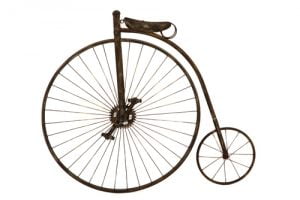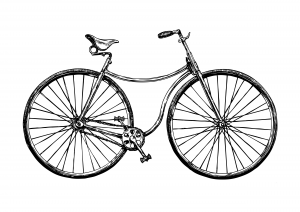
The fax machine, cassette player, DVD, Walkman, and calculator are a few examples of technology that has come and gone in the 20th-century. However, there’s one early 19th-century invention that’s very much still with us. What is it?……………. Of course, it’s the bicycle! In fact, the humble ‘bike’ is now more popular than it has ever been in its 200-year history.
Forerunners to the ”Bike”
The story of the bicycle begins with a sketch dated circa 1500, that was unearthed in the 1960s. The rudimentary drawing is attributed to Gian Giacomo Caprotti, a pupil of Leonardo da Vinci. However, a design prototype was never produced, with some leading experts declaring the drawing to be a “purposeful fraud”. The next equally contentious claim on the origins of the bicycle dates to around 1790. Then, it’s reputed that the esoteric Comte Mede de Sivrac designed a wooden contraption that he named the “celeifere”. Somewhat similar to a child’s scooter, it had no pedals or steering mechanism. It was supposedly demonstrated at the Palais-Royal in Paris, though many have doubted the very existence of the celeifere.
In 1817, the German Baron Karl von Drais, patented what might be considered the prototype of the modern bicycle. He named it the “laufmaschine”(running machine), which consisted of a simple wooden frame with a seat, mounted on two wooden wheels. The rider sat on the machine and proceeded to gather momentum by striking their feet with the ground. Drais’s invention went on to be known by various names, including the “velocipede” (literally, fast feet), the “hobby-horse”, and the “draisine”. Drais’s machine underwent several minor improvements over the following years. It eventually saw commercial success in Britain, where it became known as the “dandy horse”.

A replica of the dandy horse. Image Credit: Denis Doronin
Boneshakers and Penny Farthings
Not until the 1860s did Drais’s machine undergo a radical transformation. Either, Frenchman Pierre Lallement, Pierre Michaux, or his son Ernest Michaux, came up with the idea to add a crank and pedals to the front wheel. The refined machines were dubbed ”bicycles”, though they soon developed the nickname ”boneshakers”, reflecting the rough ride that could be expected.
Inventors Eugène Meyer and James Starley, amongst others, sought to overcome the problem of bicycle stability by the introduction of an outsized front wheel. The new machines were dubbed “penny-farthings” or “ordinaries,” and greatly helped to popularise cycling in the 1870s. Cycling clubs and competitive racing also soon became popular. Englishman Tom Stevens took enthusiasm for the bicycle one step further. In April 1884, he set off on a 32-month adventure on an American-built penny farthing to become the first person to transverse the world on a bicycle.

A typical penny-farthing. Image Credit: Brittny
The Safety Bicycle
Penny-farthings had greatly helped to promote bicycle use. However, their unstable design meant that cycling was still viewed as a relatively dangerous pursuit by many. That changed in 1885 when John Kemp Starley, the nephew of James Starley, came up with the ‘safety bike’. Kemp’s new bicycle design featured two same-sized wheels. The rear wheel was connected to pedals by a driven chain, making the bicycle much more steerable. The equal-sized wheels also made the bike far more stable than the penny-farthing. The improvements saw Kemp’s machine dubbed the ‘safety bike’. Improvements to bicycle braking systems soon followed. In 1887, John Dunlop produced the first practical pneumatic tyre for the bicycle. Thus, the basic template for the modern bicycle was now complete.

The Safety Bicycle. Image Credit: Babich Alexander
The Golden Age of Cycling
The invention of the safety bike saw standardisation in bicycle design across the world. Thus, the cost of a bicycle fell dramatically, making it affordable to almost everyone across the globe. This herald in the ‘Golden Age of Cycling’, which lasted between the 1900s and 1950s. In this period, bicycles became a primary means of transport for the masses. In the developing world, the large-scale use of the bicycle lasted much longer. It’s only since the end of the 20th-century that we have seen the motorcycle begin to replace the bicycle as the world’s primary method of transport.
Cycling in the Modern Era
The modern age of cycling in the developed world arguably began in the 1970s. That’s when cycling began to be recognised as a highly beneficial form of exercise. The development of the mountain bike, BMX, and hybrid bike, as well as the road bike itself, has helped to popularise cycling even more. Cycling, as both a sport and pastime, has never enjoyed such a high profile or participation level. In a changing world, the bicycle is now more than ever seen as an inexpensive, healthy, and environmentally friendly mode of transport for all.
Best estimates for today put global ownership of bicycles at around one billion. It’s thought around 45 percent of those are owned by the Chinese. However, it’s the Danes who enjoy the world’s greatest bicycle ownership per capita, which stands at about 90 percent.

Cycling is now more popular than ever. Image Credit: Maxpro
Header credit image: Martin Bergsma/Shutterstock.com
NB – All other images are also jointly credited to Shutterstock.com
If you’ve enjoyed reading this article, why not click on the link to Hobbies and Pastimes, to see if there’s anything else that takes your interest?




